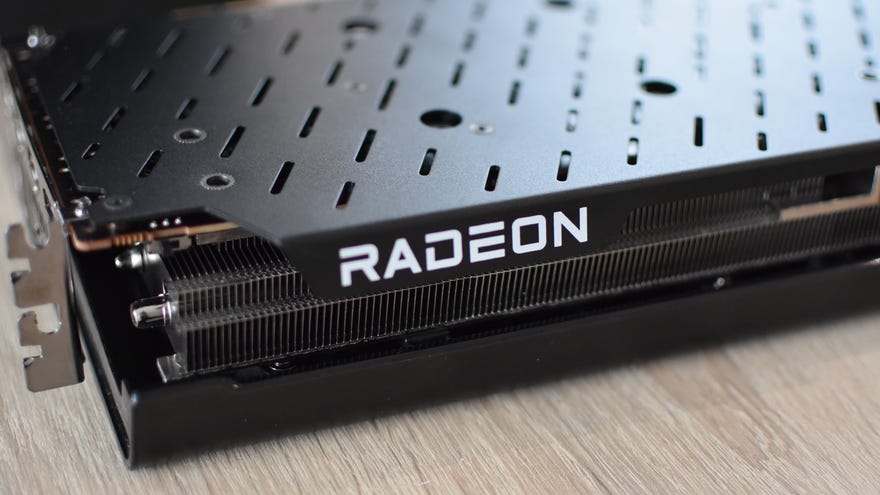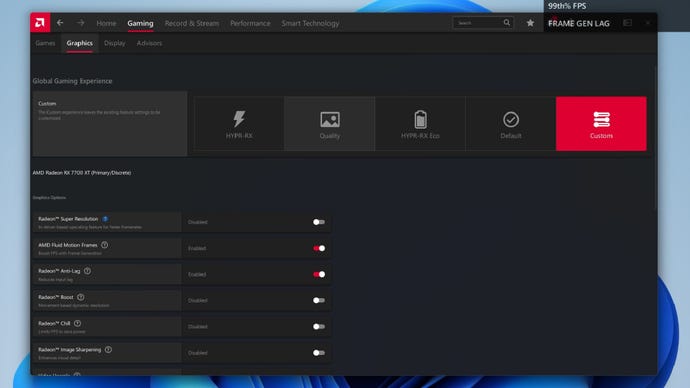HomeHardwareFeatures
Should You Bother With… AMD Fluid Motion Frames?Putting discount frame gen to the test in a new RPS feature
Putting discount frame gen to the test in a new RPS feature
Image credit:Rock Paper Shotgun
Image credit:Rock Paper Shotgun

Welcome toShould You Bother With, a new, hopefully somewhat regular RPS column where I’ll investigate the quirkier niches that PC gaming hardware has to offer. Through trial and testing, together we’ll find out which of these products and features are technological red herrings – and which are the genuine innovations that deserve your attention.
First up on the lab table:AMD Fluid Motion Frames!
What, though, of Fluid Motion Frames? This is another frame generation tool of AMD’s, but because it’s built into their Adrenalin graphics drivers (rather than needing per-game integration), its compatible games list theoreticallty numbers in the thousands. All they need is to be built on DirectX 11 or 12, which most are these days, and to let you turn V-Sync off. Also not much of a drawback, when gaming monitors withFreeSyncsupport are so common and affordable.
Image credit:Rock Paper Shotgun

We can see that Fluid Motion Frames can, at times, more than double overall framerates in multiple games. It can even outpace the more ‘advanced’ FSR 3’s frame generation inLike a Dragon: Infinite Wealth, too. In some moments, the added frames forced performance beyond the effective FreeSync range of my 144Hz monitor, so faster-running games may need to be limited (either through in-game settings or an app like Rivatuner) to prevent their FMF-boosted performance from climbing in screen tear territory.
It’s not just shiny new graphics cards that can benefit, either. Despite being marketed as a premium feature, frame generation should be ideal for helping slowpoke GPUs stave off obsolescence, and the low-budget, last-genRadeon RX 6500 XTshowed it could make up the numbers as well:
On this card, Fluid Motion Frames isn’t as effective at preventing framerate drops as FSR 3 frame gen is, but the driver-level system is still capable of nearly doubling the total output.
Importantly, the generated frames manage to slip in pretty much unnoticed, in the sense that you can can’t tell – not with the naked eye – which frames are real and which ones the driver has drawn up itself. As with DLSS 3, there may be imperfections if you manage to screengrab a fake frame to peer at in isolation, but such errors are practically invisible when running and playing the game normally. They’re just not on the screen long enough.
It is, to be sure, impressive that a bit of post-processing jiggerypokery can come this close to emulating engine-based frame gen performance. Unfortunately, comparing the actualexperienceof using Fluid Motion Frames to the likes of DLSS 3 – and not just benchmark numbers – is where its real problems begin.
Image credit:Rock Paper Shotgun/CD Projekt Red

Still, that’s true of all the current frame generation options, including the best-in-class DLSS 3. Where Fluid Motion Frames really falters is that a lot of the time, it’s not even fulfilling the “look better” part. Stuttering is a major problem, to the point where Infinite Wealth looked visibly smoother on FSR 3 than with Fluid Motion Frames. Big stutters and tiny yet consistent microjitters were evident across all three of my test games, undermining the point of raising framerates in the first place.
FMF’s technique for minimising visible interpolation errors might also be more trouble than it’s worth. Frame gen systems, even DLSS 3, tend to struggle with accurately drawing frames just after a sudden camera, scene, or perspective change, because they don’t have applicable reference frames that the PC has already rendered normally. To get around this, Fluid Motion Frames simply doesn’t bother, temporarily disabling itself when it detects sudden big changes onscreen. I can see why this makes sense, but in practice, it was shutting off every time I swung the camera around in Horizon Zero Dawn, or made a sharp turn while driving in Cyberpunk 2077. This creates averyperceptible framerate drop whenever it happens, to the point where I kinda wish AMD had just stuck to their guns and let the messed-up frames fly. When they’re only visible for 10ms or so, and are sandwiched between perfectly rendered, ‘real’ frames, I’m not sure they’d have been a problem anyway.
Image credit:Rock Paper Shotgun/Sega

Also, remember how I said it might take some tweaking to stay within FreeSync range? Well, that can be a waste of time as well, as Fluid Motion Frames itself managed to induce its very own screen tearing even when performance was well within my monitor’s 48-144Hz sync range.
It’s this roughness that proves to be Fluid Motion Frames’ undoing, even with its commendable software agnosticism and eye-catching max framerate figures. Even if we accept that frame generation can’t truly replicate the slick feeling of 100fps-plus games on a less powerful card, it’s still ultimately about improving gaming visuals. If this driver-based version actively introduces stuttering and jittering and screen tearing that somehow defeats AMD’s own anti-screen tearing tech, we can’t honestly say it succeeds, no matter how many different games it’s compatible with.
Verdict: Should you bother with AMD Fluid Motion Frames?No, not without significant updates focused on improving smoothness and reducing artefacts.